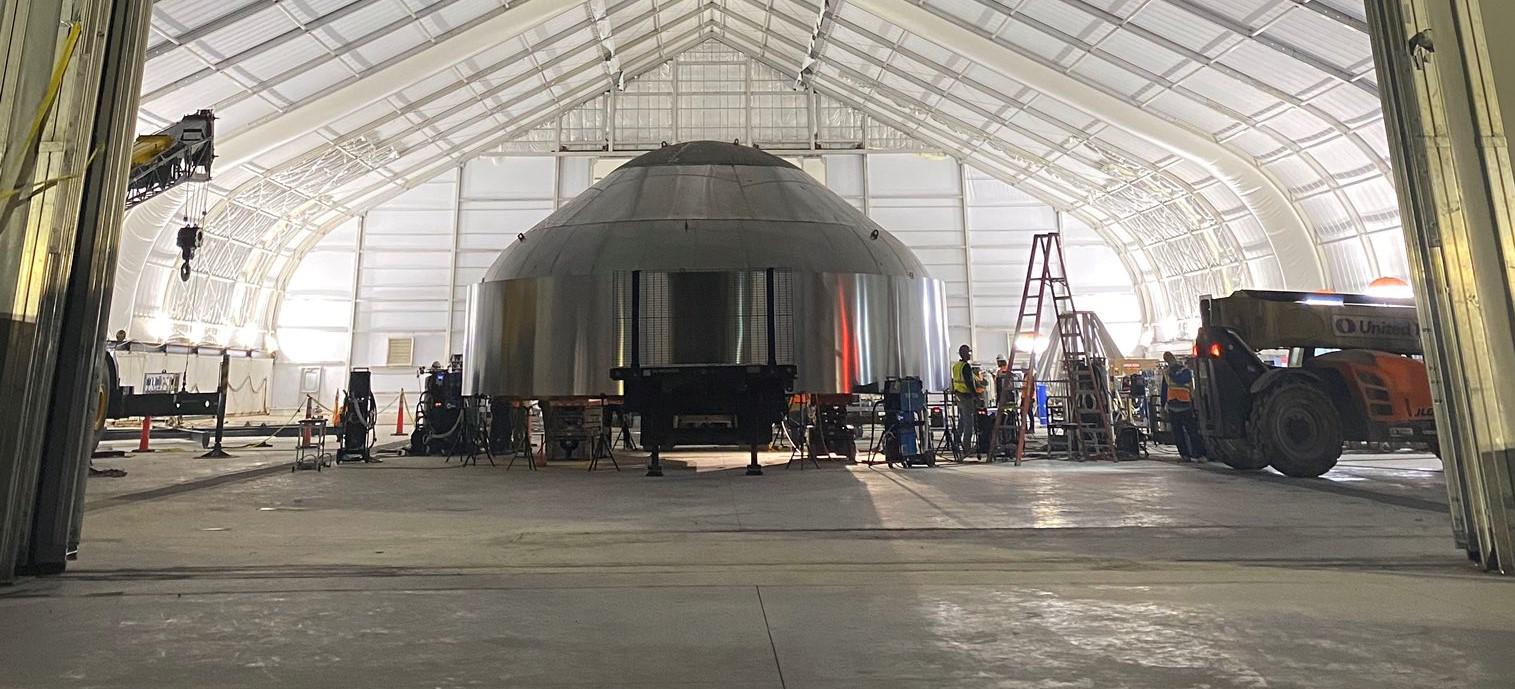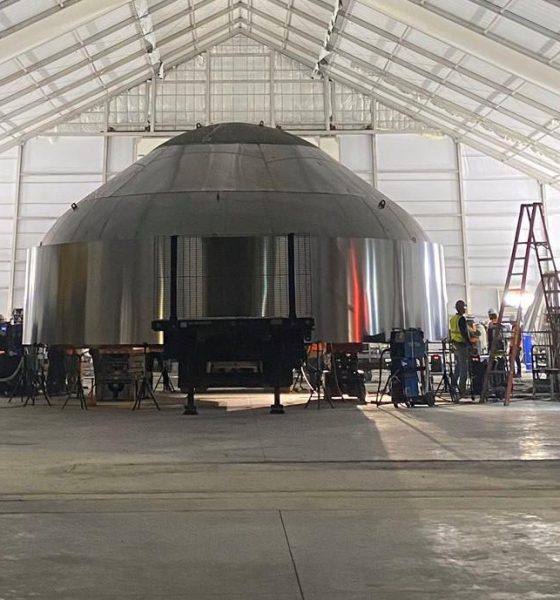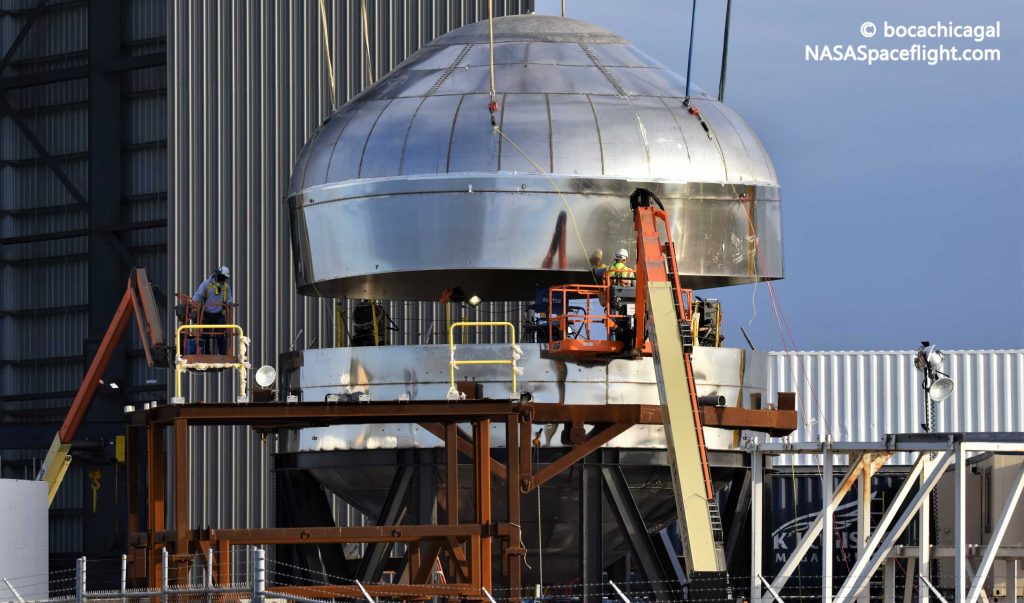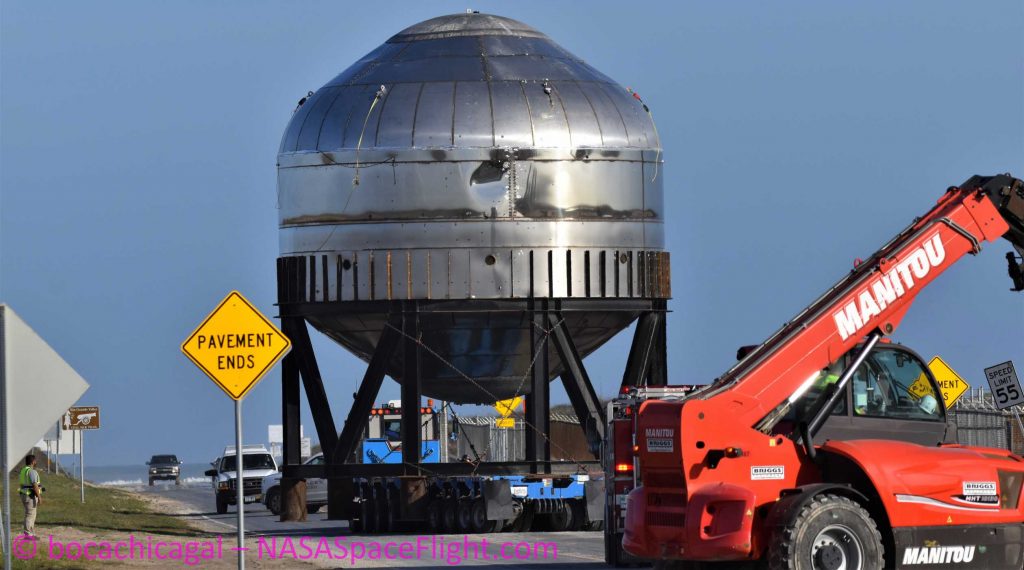

News
SpaceX Starship factory churning out new rocket parts with Elon Musk's help
SpaceX’s South Texas team of Starship engineers and technicians – including CEO Elon Musk himself – are working around the clock to manufacture hardware that will likely become the company’s next Starship prototype in the near future.
Over the last few days, SpaceX has made quick progress churning out shiny steel rings and wrapping up propellant tank domes – the next round of full-scale Starship hardware. To better build the first flight and orbit-capable prototypes, not to mention hundreds or even thousands of Starship spacecraft and Super Heavy boosters in the years to come, SpaceX teams and contractors have spent the last two months aggressively expanding the company’s Boca Chica, Texas facilities. In fact, the very same company that built Tesla’s newest tent-based Model 3 assembly line – Sprung Instant Structures – has erected part of a massive, new Starship factory.
Finally giving the company’s grizzled South Texas team a large, climate-controlled space to work from, CEO Elon Musk has also been spending more and more time at SpaceX’s upgraded Boca Chica facilities. Most recently, the executive gave Twitter followers the first official glimpse inside one of the new Starship production tents, revealing several giant spacecraft parts in various stages of completion. It’s currently unclear what the destiny of that new Starship hardware will be, but a few recent clues seem to point in one specific direction.
Yeah, we just finished two more propellant domes. SpaceX team & supporting suppliers are doing amazing work ramping Starship production.— Elon Musk (@elonmusk) January 22, 2020
On January 10th, SpaceX intentionally – and largely successfully – ‘popped’ a Starship propellant tank to determine the quality of partially-upgraded manufacturing and assembly techniques. Built in just two weeks, Musk revealed shortly after the test that the baby Starship tank – filled with water – had made it to 7.1 bar (103 psi) before bursting.
While fairly meaningless on its own, it apparently means that the test tank survived well past the pressures Starships will need for orbital flight, although it only managed a safety margin of ~18%. To be fully flightworthy, Musk says that SpaceX wants Starship tanks to survive pressures of at least 8.5 bar (125 psi) – a margin of ~40% – before it considers the giant spacecraft safe enough for humans.

Given that the 7.1 bar the test tank reached is more than enough to support “orbital flight”, albeit with a less-than-optimal safety margin, it would be reasonable to assume that SpaceX would choose to immediately green-light the first flightworthy Starship spacecraft, deemed SN01 (serial number 01) by Musk. While that first prototype would thus be unable to launch humans and fulfill its ultimate goal as a Starship, it would give SpaceX experience building a second full-scale prototype (following Mk1) and give the company time to gradually upgrade its production facilities and manufacturing hardware.
Musk sketched out a number of possible improvements even before SpaceX tested its miniature Starship tank to destruction, indicating that “more precise parts” and an enclosed, wind-protected welding shop should be enough to raise Starship’s safety margin to ~40%. A step further down the road, Musk raised autogenous laser welding as a possibility for future production upgrades, although the advanced welding method would require a truly controlled environment and much more precise parts and manufacturing hardware.

In the last 24 hours, SpaceX has filed for a number of road closures for the highway adjacent to its Boca Chica Starship facilities, a sign that some form of rocket hardware transport and testing is imminent. As such, it now seems much more likely that SpaceX has decided to spend at least a few more weeks building and testing a second (and possibly a third) Starship tank prototype before kicking off the production of the next full-scale rocket.
Intriguingly, SpaceX has also received several large shipments of liquid nitrogen (LN2), a neutral cryogenic fluid often used to simulate cryogenic propellants without risking a massive explosion or fire. That LN2 wont last forever in SpaceX’s storage tanks, confirming that some form of cryogenic testing is imminent. The most likely explanation is that SpaceX is in the late stages of manufacturing a second tank prototype, soon to be shipped about a mile down the road to the company’s nearby test and launch facilities.
If SpaceX is planning to perform a burst test with liquid nitrogen, it will likely be quite the spectacle – much closer to Starship Mk1’s spectacular failure than the milder demise of the first miniature Starship tank. SpaceX has roadblocks scheduled every day for the rest of the week, so stay tuned to find out when exactly Starship’s next big test is expected.
Check out Teslarati’s Marketplace! We offer Tesla accessories, including for the Tesla Cybertruck and Tesla Model 3.

News
Tesla aims to combat common Full Self-Driving problem with new patent
Tesla writes in the patent that its autonomous and semi-autonomous vehicles are heavily reliant on camera systems to navigate and interact with their environment.

Tesla is aiming to combat a common Full Self-Driving problem with a new patent.
One issue with Tesla’s vision-based approach is that sunlight glare can become a troublesome element of everyday travel. Full Self-Driving is certainly an amazing technology, but there are still things Tesla is aiming to figure out with its development.
Unfortunately, it is extremely difficult to get around this issue, and even humans need ways to combat it when they’re driving, as we commonly use sunglasses or sun visors to give us better visibility.
Cameras obviously do not have these ways to fight sunglare, but a new patent Tesla recently had published aims to fight this through a “glare shield.”
Tesla writes in the patent that its autonomous and semi-autonomous vehicles are heavily reliant on camera systems to navigate and interact with their environment.

The ability to see surroundings is crucial for accurate performance, and glare is one element of interference that has yet to be confronted.
Tesla described the patent, which will utilize “a textured surface composed of an array of micro-cones, or cone-shaped formations, which serve to scatter incident light in various directions, thereby reducing glare and improving camera vision.”

The patent was first spotted by Not a Tesla App.
The design of the micro-cones is the first element of the puzzle to fight the excess glare. The patent says they are “optimized in size, angle, and orientation to minimize Total Hemispherical Reflectance (THR) and reflection penalty, enhancing the camera’s ability to accurately interpret visual data.”
Additionally, there is an electromechanical system for dynamic orientation adjustment, which will allow the micro-cones to move based on the angle of external light sources.
This is not the only thing Tesla is mulling to resolve issues with sunlight glare, as it has also worked on two other ways to combat the problem. One thing the company has discussed is a direct photon count.
CEO Elon Musk said during the Q2 Earnings Call:
“We use an approach which is direct photon count. When you see a processed image, so the image that goes from the sort of photon counter — the silicon photon counter — that then goes through a digital signal processor or image signal processor, that’s normally what happens. And then the image that you see looks all washed out, because if you point the camera at the sun, the post-processing of the photon counting washes things out.”
Future Hardware iterations, like Hardware 5 and Hardware 6, could also integrate better solutions for the sunglare issue, such as neutral density filters or heated lenses, aiming to solve glare more effectively.
Elon Musk
Delaware Supreme Court reinstates Elon Musk’s 2018 Tesla CEO pay package
The unanimous decision criticized the prior total rescission as “improper and inequitable,” arguing that it left Musk uncompensated for six years of transformative leadership at Tesla.

The Delaware Supreme Court has overturned a lower court ruling, reinstating Elon Musk’s 2018 compensation package originally valued at $56 billion but now worth approximately $139 billion due to Tesla’s soaring stock price.
The unanimous decision criticized the prior total rescission as “improper and inequitable,” arguing that it left Musk uncompensated for six years of transformative leadership at Tesla. Musk quickly celebrated the outcome on X, stating that he felt “vindicated.” He also shared his gratitude to TSLA shareholders.
Delaware Supreme Court makes a decision
In a 49-page ruling Friday, the Delaware Supreme Court reversed Chancellor Kathaleen McCormick’s 2024 decision that voided the 2018 package over alleged board conflicts and inadequate shareholder disclosures. The high court acknowledged varying views on liability but agreed rescission was excessive, stating it “leaves Musk uncompensated for his time and efforts over a period of six years.”
The 2018 plan granted Musk options on about 304 million shares upon hitting aggressive milestones, all of which were achieved ahead of time. Shareholders overwhelmingly approved it initially in 2018 and ratified it once again in 2024 after the Delaware lower court struck it down. The case against Musk’s 2018 pay package was filed by plaintiff Richard Tornetta, who held just nine shares when the compensation plan was approved.
A hard-fought victory
As noted in a Reuters report, Tesla’s win avoids a potential $26 billion earnings hit from replacing the award at current prices. Tesla, now Texas-incorporated, had hedged with interim plans, including a November 2025 shareholder-approved package potentially worth $878 billion tied to Robotaxi and Optimus goals and other extremely aggressive operational milestones.
The saga surrounding Elon Musk’s 2018 pay package ultimately damaged Delaware’s corporate appeal, prompting a number of high-profile firms, such as Dropbox, Roblox, Trade Desk, and Coinbase, to follow Tesla’s exodus out of the state. What added more fuel to the issue was the fact that Tornetta’s legal team, following the lower court’s 2024 decision, demanded a fee request of more than $5.1 billion worth of TSLA stock, which was equal to an hourly rate of over $200,000.
Delaware Supreme Court Elon Musk 2018 Pay Package by Simon Alvarez
News
Tesla Cybercab tests are going on overdrive with production-ready units
Tesla is ramping its real-world tests of the Cybercab, with multiple sightings of the vehicle being reported across social media this week.

Tesla is ramping its real-world tests of the Cybercab, with multiple sightings of the autonomous two-seater being reported across social media this week. Based on videos of the vehicle that have been shared online, it appears that Cybercab tests are underway across multiple states.
Recent Cybercab sightings
Reports of Cybercab tests have ramped this week, with a vehicle that looked like a production-ready prototype being spotted at Apple’s Visitor Center in California. The vehicle in this sighting was interesting as it was equipped with a steering wheel. The vehicle also featured some changes to the design of its brake lights.
The Cybercab was also filmed testing at the Fremont factory’s test track, which also seemed to involve a vehicle that looked production-ready. This also seemed to be the case for a Cybercab that was spotted in Austin, Texas, which happened to be undergoing real-world tests. Overall, these sightings suggest that Cybercab testing is fully underway, and the vehicle is really moving towards production.
Production design all but finalized?
Recently, a near-production-ready Cybercab was showcased at Tesla’s Santana Row showroom in San Jose. The vehicle was equipped with frameless windows, dual windshield wipers, powered butterfly door struts, an extended front splitter, an updated lightbar, new wheel covers, and a license plate bracket. Interior updates include redesigned dash/door panels, refined seats with center cupholders, updated carpet, and what appeared to be improved legroom.
There seems to be a pretty good chance that the Cybercab’s design has been all but finalized, at least considering Elon Musk’s comments at the 2025 Annual Shareholder Meeting. During the event, Musk confirmed that the vehicle will enter production around April 2026, and its production targets will be quite ambitious.








